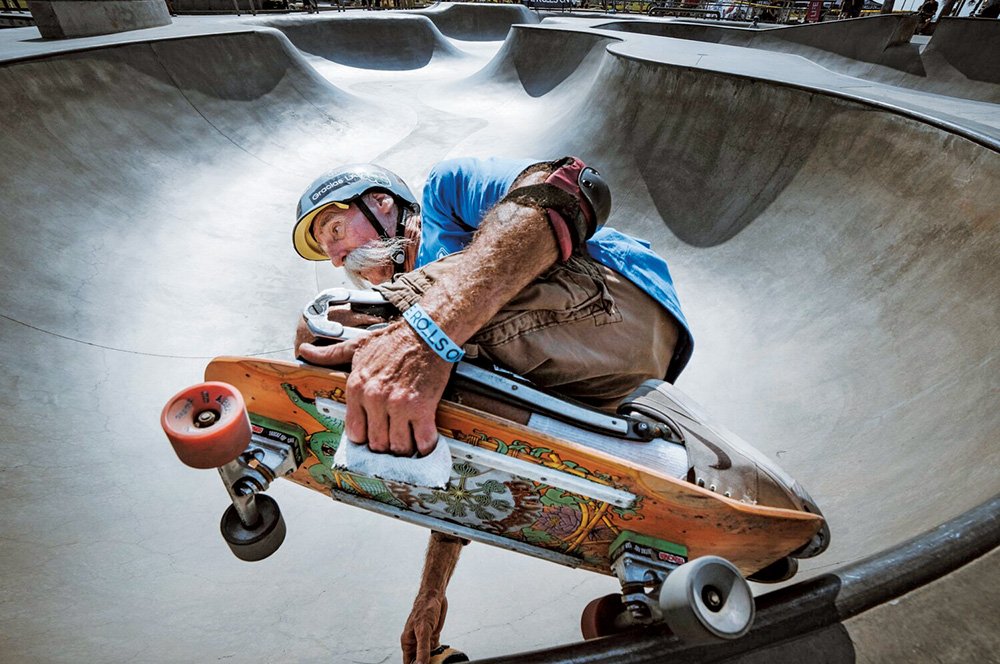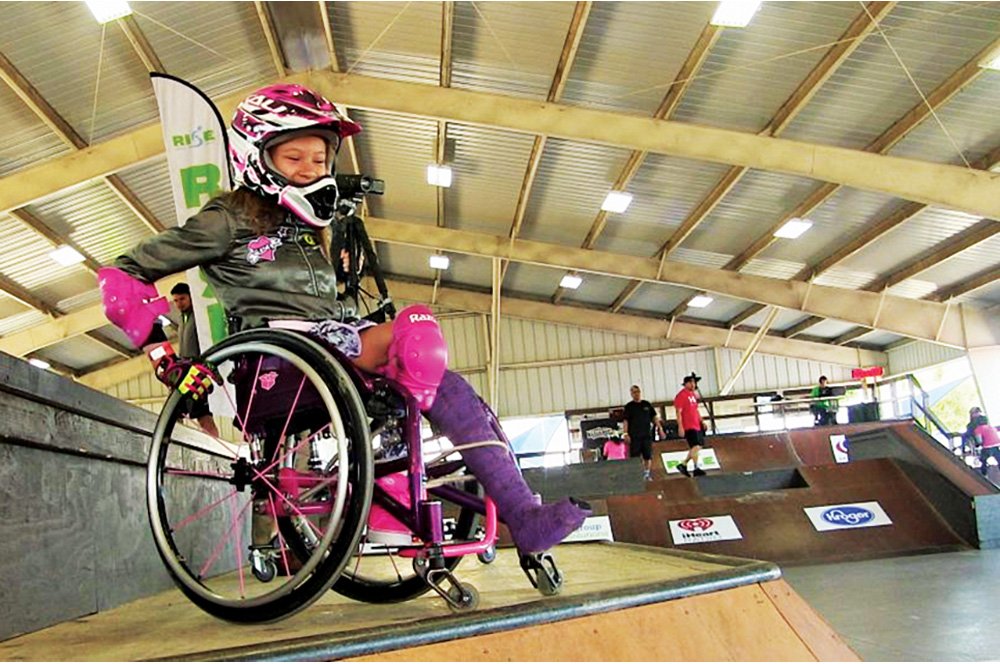Adaptive Skating
Focus on ability instead of disability
By Heidi Lemmon
Public skateparks have come a long way in the last 25 years; they are no longer single- or even double-use facilities. Chances are your park is being used by skateboarders, BMX riders, scooters, rollerbladers, roller skaters, and even wheelchairs. All genders, all ages, abled and disabled riders, create a huge melting pot of active users who make a skatepark the most welcoming play space in a city. Even the Olympics has added skateboarding, freestyle BMX, and adaptive riding, and there is a lot of buzz about how to design a park to get the most use per square foot.
Max Dunlap at Life Rolls On
Laura Island, a Supervisor for the city of Los Angeles’ Citywide Adaptive Recreation Division, holds multiple events for disabled children at its skateparks through a partnership with Los Angeles Olympics 2028 (LA 28), funded by Play LA Youth, and Adaptive Youth Sports programing, and is thrilled with the results. She says parents and children are excited and grateful for the opportunity to explore their abilities at the same facility and at the same time as their friends and family. She adds that often a sibling or family member who skates encourages a disabled rider by pushing that person in the park. And the city’s adaptive classes, which can accommodate 15 per class, have been a hit.
“The turnout for the adaptive skate is fabulous, and, so far, all our classes have been full,” she says.
So, what can you do to make a skatepark ADA-friendly? Begin by having an ADA-compliant restroom, reachable water fountain, and ramp into the park.
Here are some more ideas:
Keep some flat platform areas for seating, and wheelchair access to the various features.
Make platforms and quarter-pipe platforms wide enough to turn a wheelchair around (a suggested minimum is 48 inches).
Create a waterfall in the bowls. A waterfall at the entrance to a bowl consists of a 4-foot drop, followed by another 4- to 6-foot drop into the deep end. This cascading entrance also allows paramedics easier access to remove an injured rider. This is important for all riders, not only adaptive ones. Without this feature, paramedics must set up scaffolding in order to remove an injured rider. Time is important.
Where To Begin
The safest and easiest way to include adaptive riders is to contact an experienced organization. Many groups will be happy to provide a workshop or event if you partner with them; some may request a fee or travel expenses.
Here are some resources to pursue:
ASF Adaptive Sports www.asfadaptivesports.org
ASF Adaptive Sports is a division of Action Sports Foundation, based in St. Petersburg, Fla. The organization works with youth groups, other organizations, athletes, and sport participants to provide adaptive-sports training opportunities in a fun and safe manner. Members of ASF have been active in action sports for most of their lives, primarily in skateboarding, BMX, and water sports. The organization and its supporters are athletes, coaches, and industry friends dedicated to providing adaptive-sports opportunities in their communities.
ASF Foundation WXMC Championships
Action Park Alliance https://actionparkalliance.com/
Managed by Mark Laue, this organization partners with cities and communities to manage public skateparks. They also produce adaptive events, including the WCMX World Championships.
Askate Foundation www.askate.org
Parents of children with autism founded Askate in 2010 as a way for their children to be in a place where they are accepted. Clinics are held nationwide at no cost to the families. Skateboarding has proven to be very successful with autistic kids; in fact, according to one of the founders, Chrys Worley, “It’s been proven hundreds of times over with every skate clinic Askate offers along the Eastern seaboard. We have yet to have even one child that doesn't respond well to the clinics.”
Speaking From Experience
Los Angeles City Play LA
Dew Tour 2021 Silver Medalist Tracie Garacochea calls Venice, Calif., her home park, but she also skates via her wheelchair in many other parks. What she looks for in a park are a few features she can handle. She also appreciates that a skatepark is the one place where she can skate while socializing with her friends and peers. Her wish for new skateparks is installing a ledge on the quarter pipes that is wide enough to turn her chair around; she says 48 inches would do the trick. The ledge is not something that can be added to an existing park, but is easy to spec into a new park design.
Take the next step in health and fitness for individuals with disabilities and consider making your skatepark accessible for adaptive riding. Residents will be thrilled to have another option—and passion—to pursue.
Heidi Lemmon is the executive director of Skate Park Association International, as well as a board member for IBMXFF and the World Freestyle Skateboard Association. She is the producer of the OG Jam series. Reach her at Sk8pks@aol.com.
For More Information
Not sure what you will be getting into? Check out Tin Soldiers, an inspiring documentary by Ben Duffy, which gives a fascinating perspective into the world of amputees, people who have spina bifida, and those paralyzed—all participating in adaptive sports. This independent film is the passion project of Duffy, Michael J Sassano, and executive producer Jeff Bourns. Feeling better psychically and mentally is the key to feeling better emotionally, which begins to resolve the most difficult challenge people with these conditions face—overcoming depression. The film is about believing in oneself through adapting. Watch the trailer at https://player.vimeo.com/video/148156551.



